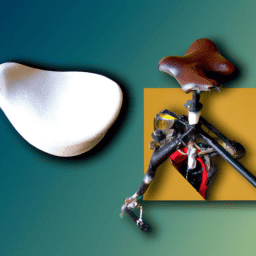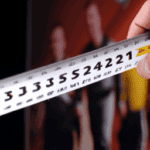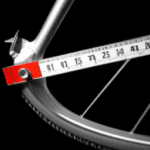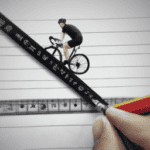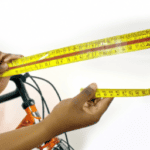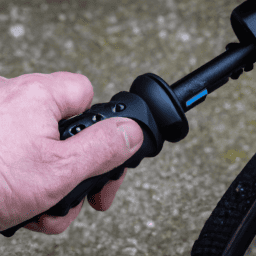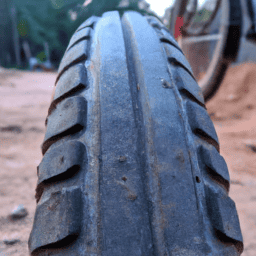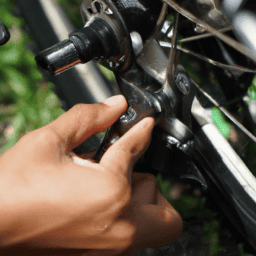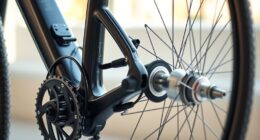As someone who is passionate about cycling, I’ve come to understand how critical it is to have a bike that fits properly. Using a bicycle that doesn’t match your body size can lead to discomfort, pain, and potential injuries. Therefore, it’s essential to accurately determine the size of the bike you need before buying a new one or making adjustments to an existing bike.
To measure your bike size, you’ll need to take into account your body measurements and use a bike size chart. It may sound intimidating, but with a little bit of patience and attention to detail, you can easily determine the right bike size for you.
In this article, I’ll guide you through the steps of measuring your bike size and offer tips on how to make necessary adjustments to ensure a comfortable and safe ride. So let’s get started!
Key Takeaways
- Proper bike sizing is crucial for comfort, safety, and performance while riding
- Body measurements and a bike size chart are needed to accurately measure bike size, but adjustments may be necessary for different body types
- Alternative sizing methods, such as physically trying out different sizes or seeking advice from a professional, can provide a more accurate fit
- Adjustments to components like the saddle, stem, and handlebars can be used to fine-tune the fit, and fitting accessories can enhance comfort and performance.
Understand the Importance of Proper Bike Sizing
You gotta make sure your bike fits you like a glove, otherwise you’ll be in for a world of discomfort and potential injury. The importance of comfort cannot be overstated when it comes to cycling.
Riding a bike that doesn’t fit properly can lead to a host of problems, including aches and pains in the back, neck, and shoulders, as well as numbness in the hands and feet. It can also impact your performance, making it harder to pedal efficiently and putting unnecessary strain on your muscles.
When it comes to cycling, every inch matters. That’s why it’s so important to take the time to determine your body measurements before buying a bike.
Not only will this ensure that you get a bike that fits you properly, but it will also help you choose the right style and size of bike for your needs.
So let’s dive into the next step and learn how to measure your body for the perfect bike fit.
Determine Your Body Measurements
Before determining your body measurements, it’s important to note that different body types may require adjustments to the standard sizing charts. It’s crucial to get the right size bike to avoid discomfort, injury, or even accidents.
To accurately measure your bike size, you need to be familiar with measuring techniques and have knowledge of your body proportion. To measure your body accurately, you need to have a tape measure, a pencil, and a friend to assist you.
First, stand upright wearing tight-fitting clothing and without shoes. Then, measure your inseam from the ground to your crotch. Next, measure your torso from your crotch to your shoulder. Finally, measure your arm length from your shoulder to your wrist.
Knowing your body measurements is crucial in determining whether a particular bike size is right for you. Now that we have determined our body measurements, it’s time to use a bike size chart to find the right size bike.
Use a Bike Size Chart
Take a look at the bike size chart to easily find the perfect fit for your body type! Using a bike size chart is a reliable way to determine the right frame size for your bicycle.
However, there are some common misconceptions about using a chart that need to be addressed. Firstly, it’s important to note that bike size charts may vary slightly between manufacturers. Therefore, it’s crucial to consult the specific chart for the brand and model of bike you’re interested in purchasing.
Additionally, while bike size charts are a great starting point, they shouldn’t be the only resource used to determine the ideal frame size. Alternative sizing methods, such as physically trying out different sizes or seeking advice from a professional, can provide a more accurate fit for your unique body type.
Consulting a bike size chart is just one step towards finding the perfect fit for your bicycle. In the next section, we’ll discuss the importance of test riding and adjusting your bike to ensure maximum comfort and performance.
Test Ride and Adjust
When test riding a bike, I always make sure to try out different sizes to find the best fit.
Once I’ve found a size that feels comfortable, I make small adjustments such as adjusting the seat height or handlebar position to further optimize my riding position.
It’s important to listen to your body and make adjustments accordingly to avoid discomfort or injury while riding.
Try Different Sizes
Experiment with various bike sizes until you find one that feels comfortable and fits you like a glove. Size variations are common between different types of bikes and brands, so it’s important to try out a range of sizes before making a purchase.
Fit preference also plays a role in selecting the right size, as some riders prefer a more upright or aggressive riding position. When trying out different sizes, pay attention to how the bike feels in terms of reach, standover height, and handlebar height.
It’s important to note that the size of the bike frame is not the only factor in determining comfort and fit. Other components, such as the saddle, stem, and handlebars, can also be adjusted to fine-tune the fit.
Once you have found a size that feels good, make small adjustments to these components to further customize the fit to your body. With the right size and adjustments, you’ll be able to ride comfortably and efficiently for hours on end.
Make Small Adjustments
Previously, I suggested trying out different bicycle sizes to determine which one is the most comfortable for you. However, if you’re still not satisfied with the fit, you can always make small adjustments to find the perfect size. There are a variety of adjustment techniques that you can use to fine-tune your bike’s fit, such as changing the saddle height or angle, adjusting the handlebar position, or changing the stem length.
In addition to these adjustment techniques, there are also fitting accessories that you can use to enhance your comfort and performance on the bike. For example, you might consider adding a gel saddle cover for extra cushioning or investing in a pair of cycling shoes that provide better support and power transfer. Ultimately, the goal of these adjustments and accessories is to ensure that your bike fits you like a glove, allowing you to ride more efficiently and comfortably.
By taking the time to make these small adjustments and invest in fitting accessories, you’ll be able to customize your bike to your unique needs and preferences. As a result, you’ll be able to ride longer, faster, and with greater ease. In the next section, we’ll discuss how to listen to your body to ensure that you’re getting the most out of your bike and your rides.
Listen to Your Body
To truly optimize your cycling experience, it’s crucial to pay attention to the signals your body is sending you. This means being aware of your comfort level while riding.
If you’re experiencing pain or discomfort in certain areas, it may be a sign that your bike size isn’t quite right for you. One common issue is a saddle that’s too high or low.
If your saddle is too high, you’ll have to reach too far to pedal, which can put strain on your lower back and knees. Conversely, if your saddle is too low, you won’t be able to generate enough power and may feel discomfort in your knees and hips.
By listening to your body and adjusting your bike accordingly, you can improve your comfort and performance on the road. It’s important to note that while minor adjustments can be made on your own, seeking professional help may be necessary for more complex issues.
A professional bike fitting can help you determine the optimal bike size and position for your body type and riding style. By taking the time to properly measure and adjust your bike, you’ll not only feel better on the road, but also improve your overall cycling experience.
Seek Professional Help if Needed
When seeking to get the perfect fit for your bike, it’s important to consult with a professional bike shop. These experts can help ensure that your bike is adjusted to fit your body size and riding style.
Additionally, getting a professional bike fitting can provide you with more detailed information about how to customize your bike to your exact needs. Consider customized options to make your bike truly unique and perfect for you.
Seek professional help if needed.
Consult with a Bike Shop
Consulting with a bike shop is a great option for finding the right bicycle size. Did you know that, according to a survey by the National Bicycle Dealers Association, 56% of bike shop customers are repeat customers? Not only can a bike shop provide the expertise and knowledge to help you find the perfect size, but they can also offer a wide range of options to fit your budget.
Here are some benefits of consulting with a bike shop:
-
Expertise: Bike shops typically have experienced staff who can help you find the right size and type of bike for your needs. They can also provide advice on accessories and maintenance.
-
Test Rides: Most bike shops will allow you to test ride a bike before making a purchase, which can help you determine if the size is right for you.
-
Cost Comparison: While DIY options may seem cheaper, a bike shop can actually help you save money in the long run by providing quality products and services.
Getting a professional bike fitting is the next step in ensuring a comfortable and efficient ride.
Get a Professional Bike Fitting
Looking for a comfortable and efficient ride? Consider getting a professional bike fitting!
A professional bike fitting is a process where a trained professional adjusts the bike to fit the rider’s body perfectly. The benefits of fitting are many. It can help reduce pain or discomfort, improve power transfer, and increase efficiency. It can also help the rider achieve the desired riding position, which can help reduce the risk of injury and improve overall comfort.
The cost of fitting can vary depending on the bike shop and the level of customization needed. However, it’s usually a one-time investment that can make a significant difference in the rider’s riding experience.
Overall, getting a professional bike fitting is highly recommended for anyone who’s serious about their cycling. Consider customized options, such as handlebars, pedals, and saddles, to further improve your ride.
Consider Customized Options
If you truly want to enhance your cycling experience, there are plenty of customized options available to you. First and foremost, consider the pros and cons of personalized bike customization.
One of the biggest advantages is the ability to tailor your bike to your specific needs, including comfort, performance, and aesthetic preferences. However, the downside is that customized options can be costly and time-consuming, particularly if you’re not sure what you’re looking for.
Once you’ve decided that bike customization is right for you, it’s important to find a reputable bike customization service. Start by asking for recommendations from other cyclists or doing research online.
Look for a company that has a track record of high-quality workmanship and excellent customer service. When you find a service you’re interested in, schedule a consultation to discuss your options and get a quote for the work you’re considering.
With the right customized options, you can take your cycling experience to the next level.
Frequently Asked Questions
Can I use my height to determine the right size for my bike?
Using height for bike sizing has its pros and cons. It’s a good starting point, but doesn’t consider other factors like inseam length and riding style. Alternatives include bike fit measurements and test rides for a more accurate fit.
Should I consider my weight when selecting a bicycle size?
As a heavy rider, I learned the hard way that weight considerations should definitely be factored into selecting a bicycle size. Look for sturdy bike frame materials like aluminum or steel to ensure durability and safety.
How do I know if the bike is too big or too small for me?
To determine if a bike is too big or small, I recommend a bike fit assessment by a professional bike fitter. They consider factors such as saddle height, reach, and handlebar position to optimize comfort and efficiency.
Are there specific types of bikes that have unique sizing requirements?
Bike sizing for children differs from adults, with smaller frames and shorter handlebars. Road and mountain bikes have different sizing requirements, with mountain bikes typically having a smaller frame and shorter top tube.
Can I adjust the bike’s size after purchase to better fit my body?
Yes, it’s possible to adjust a bike’s size after purchase to better fit your body. Adjusting fit can involve changing the seat height or handlebar position. Professional fitting services can also help ensure optimal fit for maximum comfort and performance.
Conclusion
In conclusion, measuring the size of a bicycle is crucial to ensure a comfortable and safe riding experience. As a passionate cyclist, I’ve learned the importance of proper bike sizing and I’ve shared some tips to help you determine the right size for you.
Remember, it all starts with knowing your body measurements and using a bike size chart to get an idea of which size would be suitable. However, testing out the bike and making necessary adjustments is equally important to ensure a perfect fit. Don’t be afraid to seek professional help if needed, as a trained bike fitter can make all the difference in finding the perfect size.
Ultimately, finding the right bike size is a pivotal part of enhancing your cycling experience. A well-fitted bike can improve your performance, reduce the risk of injuries, and make your ride more enjoyable. So, take the time to measure and adjust your bike size, and get ready to hit the road with confidence!

